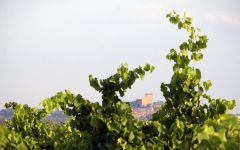Domaine de Marcoux Chateauneuf-du-Pape Vieilles Vignes (1.5 Liter Magnum) 2019
-
Jeb
Dunnuck -
Wine
Spectator -
Wine
Enthusiast -
Robert
Parker - Decanter
-
James
Suckling -
Wine &
Spirits



Product Details
Your Rating
Somm Note
Winemaker Notes
The Vieilles Vignes, a cuvée made entirely from old-vine Grenache, made in vintages where the Grenache is abundant, rich and complex. It is sourced from the sandy soils of Charbonnières (planted 1900) the limestone marl of Esquierons (planted 1900/1949) and the gravelly red clay of Gallimardes (planted 1934/1959). It is aged entirely in 350L barrels for 18 months.
Professional Ratings
-
Jeb Dunnuck
Also a true gem of a wine, the 2019 Châteauneuf Du Pape Vieilles Vignes includes all three terroirs of Charbonnière, Esqueirons and Galimardes and is all Grenache. It’s a ripe, opulent, incredibly sexy wine that’s just about overflowing with notes of raspberries, blueberries, Provençal herbs, violets, and flowers. It’s a big, exuberant Grenache offering sweet tannins, a broad, mouth-filling texture, no hard edges, and a great finish. Give it a few years and enjoy over the following two decades.
-
Wine Spectator
This is marked by a gorgeously pure core of kirsch and raspberry reduction flavors, which are laced with rooibos tea, singed balsam wood, dried anise, garrigue and warm stone notes. Extremely long, with a singular focal point to the finish as everything is pulled together by finely beaded acidity. A terrific wine. Best from 2025 through 2040.
-
Wine Enthusiast
Old vines of Grenache, averaging 55 to 110 years of age, distinguish this ripe yet nuanced wine. Matured 18 months in neutral oak, it offers black-plum and preserved-raspberry flavors that are richly concentrated but pure. Speckled with hints of licorice and smoke, it’s a feathery, sumptuous sip with a long, lifted finish. Editors’ Choice
-
Robert Parker's Wine Advocate
Marcoux's 2019 Chateauneuf du Pape Vieilles Vignes is full-bodied, dense and tannic. Hints of crushed stone and dried garrigue appear on the nose, alongside blackberries and black cherries. It's basically pure foudre-aged Grenache from two lieux-dits—Charbonnières and les Esquierons—although the old vines undoubtedly include the odd interplanted variety. This terrific wine finishes long and silky, with layers of unfolding fruit and spice, including a dash of salted licorice. Tasted twice (once blind), with consistent notes. Best after 2025
-
Decanter
Touch of licorice behind the damson and plum fruit. This has searing intensity, very high acidity with fine tannins and a good internal framework. The alcohol is high, but the other elements are even more prominent. Very long. 3,900 bottles made. 120-year-old vines planted on north-facing clay and sand lieux-dits of Charbonnières and Esquières. Fermented in concrete, aged in foudre.
-
James Suckling
Fascinating nose of black fruit, pomegranate, licorice and dried lemon zest. Very rich, deep and concentrated with a striking combination of sweetness and freshness through the long, energetic finish. Slight warmth from alcohol (16%) at the end. From organically grown grapes.
-
Wine & Spirits
Sophie Armenier pulls this wine from her family’s oldest vines, some planted more than 100 years ago. Entirely grenache fermented in tank, then aged in 350-liter barrels for 18 months, it’s a staid red in a traditional mode, with warm wood scents paneling the dark cherry fruit, and a whiff of cigar smoke. Quiet notes of roses and spice add lift and light to all the darkness, suggesting the levity that will come with time.
Other Vintages
2020-
Robert
Parker - Vinous
-
Jeb
Dunnuck -
Wine
Spectator
-
Jeb
Dunnuck -
Robert
Parker
-
Jeb
Dunnuck -
Robert
Parker - Decanter
-
Jeb
Dunnuck -
Robert
Parker
-
Wine
Spectator -
Robert
Parker
-
Robert
Parker -
Jeb
Dunnuck -
Wine
Spectator
-
Robert
Parker
-
Robert
Parker
-
Robert
Parker -
Wine
Spectator
-
Robert
Parker
-
Wine
Spectator -
Robert
Parker





In 1990, the Domaine became the first in the Chateauneuf-du-Pape to implement biodynamic farming practices. Their youngest vines are 40 to 60-years-old, and in short, the sisters do as little as possible to the harvested grapes. This domaine, as critic Stephen Tanzer put it, is "the essence of Chateauneuf-du-Pape."
In 2003, Robert Parker named Sophie and Catherine on his list of "Wine Personalities of Year," writing, "Over the last 12 years, the biodynamically farmed vineyard has risen to the top of Chateauneuf-du-Pape's quality hierarchy. The two red wines produced have been stunning, with the regular cuvée of Chateauneuf-du-Pape one of the finest in the appellation, and the limited production Cuvée Vieilles Vignes one of the world’s truly magnificent wines."

With bold fruit flavors and accents of sweet spice, Grenache, Syrah and Mourvèdre form the base of the classic Rhône Red Blend, while Carignan, Cinsault and Counoise often come in to play. Though they originated from France’s southern Rhône Valley, with some creative interpretation, Rhône blends have also become popular in other countries. Somm Secret—Putting their own local spin on the Rhône Red Blend, those from Priorat often include Merlot and Cabernet Sauvignon. In California, it is not uncommon to see Petite Sirah make an appearance.

Famous for its full-bodied, seductive and spicy reds with flavor and aroma characteristics reminiscent of black cherry, baked raspberry, garrigue, olive tapenade, lavender and baking spice, Châteauneuf-du-Pape is the leading sub-appellation of the southern Rhône River Valley. Large pebbles resembling river rocks, called "galets" in French, dominate most of the terrain. The stones hold heat and reflect it back up to the low-lying gobelet-trained vines. Though the galets are typical, they are not prominent in every vineyard. Chateau Rayas is the most obvious deviation with very sandy soil.
According to law, eighteen grape varieties are allowed in Châteauneuf-du-Pape and most wines are blends of some mix of these. For reds, Grenache is the star player with Mourvedre and Syrah coming typically second. Others used include Cinsault, Counoise and occasionally Muscardin, Vaccarèse, Picquepoul Noir and Terret Noir.
Only about 6-7% of wine from Châteauneuf-du-Pape is white wine. Blends and single-varietal bottlings are typically based on the soft and floral Grenache Blanc but Clairette, Bourboulenc and Roussanne are grown with some significance.
The wine of Chateauneuf-du-Pape takes its name from the relocation of the papal court to Avignon. The lore says that after moving in 1309, Pope Clément V (after whom Chateau Pape-Clément in Pessac-Léognan is named) ordered that vines were planted. But it was actually his successor, John XXII, who established the vineyards. The name however, Chateauneuf-du-Pape, translated as "the pope's new castle," didn’t really stick until the 19th century.
